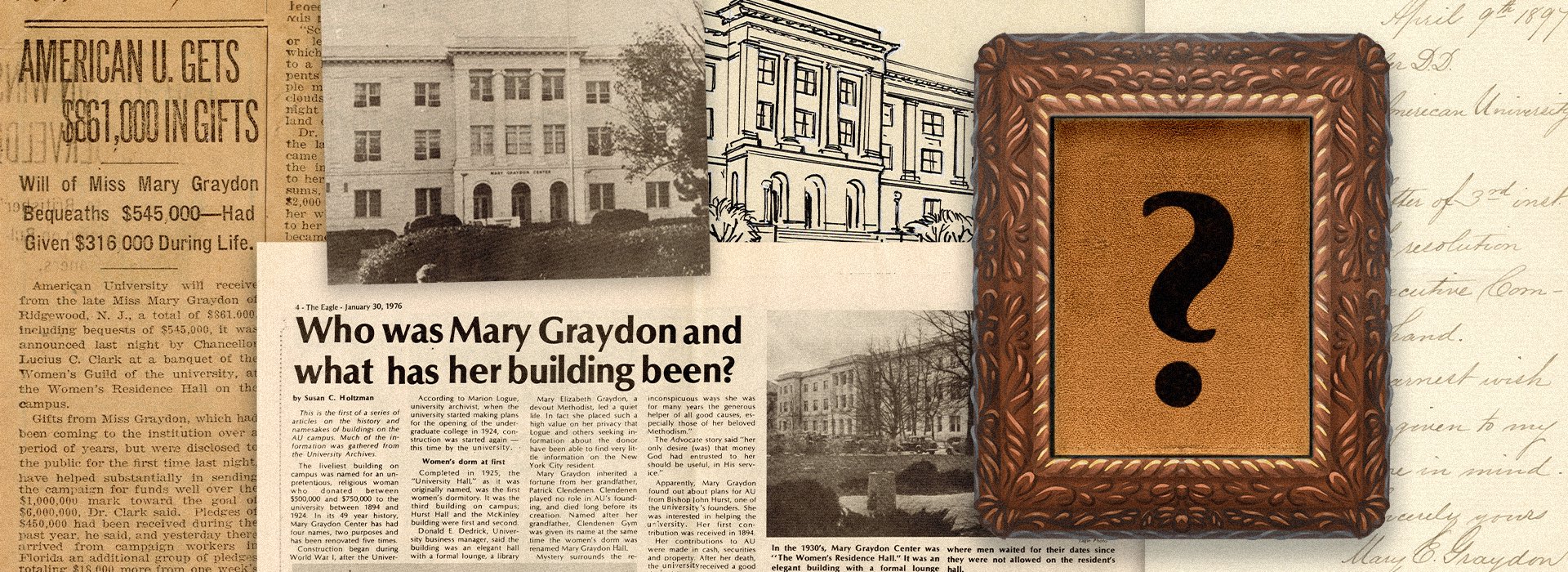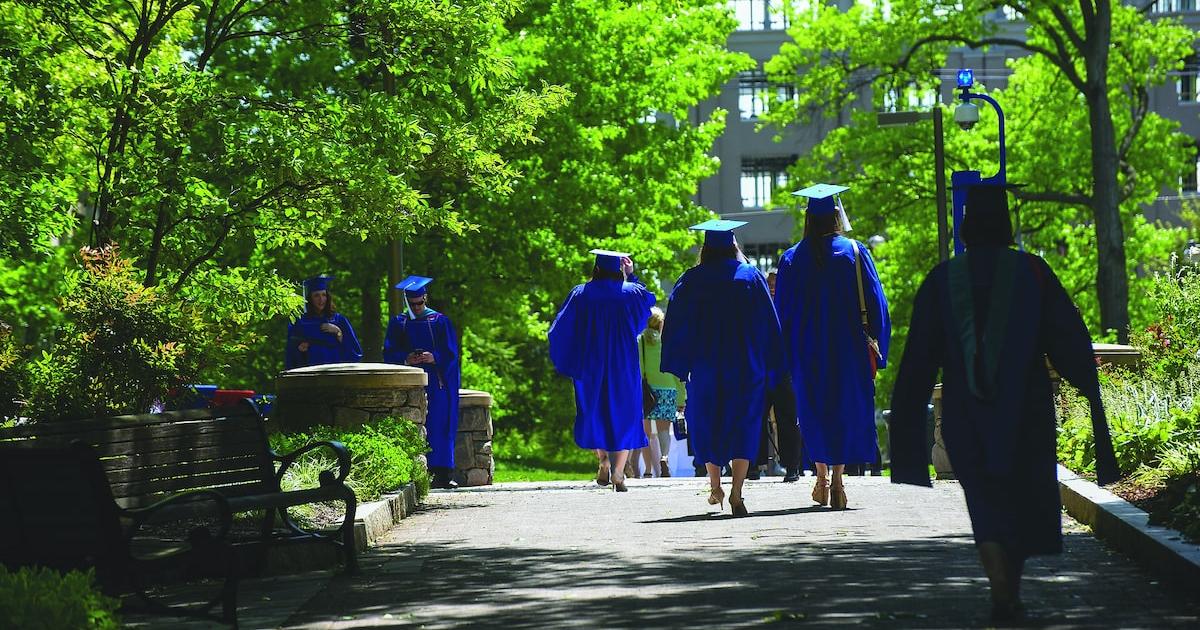
This story is part of a series spotlighting AU’s Mary Graydon Center (MGC). Central to the new Student Thriving Complex—fueled by the Change Can’t Wait campaign—MCG will be renovated to foster student engagement and community with multifunctional areas for gathering, student organizations, and events. Read the first story here.
Generations of Eagles have passed through the Mary Graydon Center (MGC) during their time on campus. But while the iconic student hub at American University has long borne her name, the story of the real Mary Graydon—the woman behind it all—retains an air of mystery.
19th-Century Heiress Turned Benefactress
Most of what is known about Mary Graydon comes from archival collections at AU and Washington College of Law. Correspondence, newspaper articles, and deeds of gifts and securities received by the university—compiled online by a student public history project— provide a glimpse into Graydon’s life.
A native of New York, NY, Graydon lived in the city for most of her life before retiring to the suburban town of Ridgewood, NJ. She was an heiress by way of her maternal grandfather, Patrick Clendenen, although the source of his fortune remains unknown.
Archival accounts indicate Graydon lived modestly despite her great personal wealth. A devout Methodist—quoted by her former pastor, Karl Quimby, as having “an unusually deep religious life”—Graydon’s faith informed much of her lifestyle and philanthropy.
It was through the Methodist Church that she connected with AU’s founding chancellor, Bishop John Hurst.
In 1894, Graydon made her first gift to AU—a grand sum of $100,755—designated to advance women’s education. Over the next 30 years, she donated nearly $1 million in cash, securities, and property, estimated to be worth nearly 15 times that today.
Modest by nature, Graydon insisted on anonymity. Only when necessary, could the name of her grandfather Patrick Clendenen be used for attribution. In an 1897 letter to AU’s vice-chancellor, Graydon stated, “My earnest wish that no publicity be given to my name will be borne in mind.”
Even in her time, Graydon was largely a mystery to the university she helped transform, and her desire to be nameless provoked curiosity and allure.
Shortly after her death in 1926, an AU faculty member wrote to Rev. Quimby, inquiring about her life. Beyond attesting to her “loving thought” and “constant stream of financial benefactions,” Quimby could give little insight into her profound philanthropy at AU.
A New Building Bears Her Name
Anonymity in philanthropy is not without precedent. Still, it’s not entirely clear how one of AU’s most iconic buildings today came to bear Graydon’s name so publicly.
A plausible explanation is the evolution of the building itself.
1918 photography shows the building was originally intended for the US Chemical Warfare Service, but plans halted with the end of World War I. Construction resumed in 1924 to support AU’s first women’s dormitory as part of the university’s new undergraduate program.
University Hall, as it was called, opened in 1925 as the third building on AU’s campus. According to a 1976 Eagle article on the building’s history, it was considered “an elegant hall” boasting a formal lounge, library, and gymnasium in its early days. It quickly became known on campus as the Women’s Residence Hall.
The first nod to Graydon came decades after the building opened. In 1945, the Women’s Residence Hall was formally renamed Mary Graydon Hall, concluding her era of anonymity. Between 1945 and 1946, the Assembly Hall Gymnasium—the site of which now hosts the Katzen Arts Center— was similarly renamed the Patrick Clendenen Gymnasium.
It remains unclear whether AU’s then-chancellor, Paul Franklin Douglass, directed the name changes or what the reasoning was.
It’s possible the decision was made to honor both Graydon’s and AU’s longstanding commitment to educating women. When AU opened in 1893, its first 28 students included five women—and the choice for a new name for a women’s residence hall reflected this lineage.
A likely source of inspiration, Graydon’s name persisted as the building continued to evolve in function and title. In 1959, it became a student center and helped house the School of Communication in the 1990s and 2000s before the school moved to the McKinley Building.
Philanthropy Lives On
Despite Graydon’s life being largely a mystery, her commitment to philanthropy remains apparent now more than ever.
Leslie Nellis, head archivist for Special Collections and Digital Initiatives at the AU University Library, points to the ongoing fascination with Graydon as evidence of her impact.
“The question ‘Who was Mary Graydon?’ has long been a source of lore and archival study here at AU,” says Nellis. “And while we’ll likely never have a complete account of Graydon’s life, AU’s archival records underscore the pivotal role her support played in the founding and early history of the university.”
As AU’s Change Can’t Wait campaign prepares to cross its finish line later this year, Graydon’s story holds special relevancy. Records show that it was, in fact, Graydon’s philanthropy that helped one of the university’s first campaigns cross the million-dollar mark.
Through her giving, Graydon advanced learning and teaching at AU—ties to which remain visible today. The Patrick Clendenen Dissertation Fellowship in Women’s and Gender History, is still awarded each year to students. A chair in the College of Arts and Sciences—currently held by Professor Pamela Nadell—similarly honors Clendenen and supports multidisciplinary research in gender studies.
Though the full scope of Graydon’s personal history will never be known, she described her mission best herself.
“I prefer to put the money into brains rather than stone and mortar,” reads an inscription attributed to Graydon on a plaque next to the entrance of MGC.
Over a century later, Graydon’s desire to support education at AU continues to inspire.
By Amber Mapel, SOC/BA ’27




